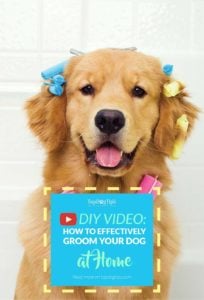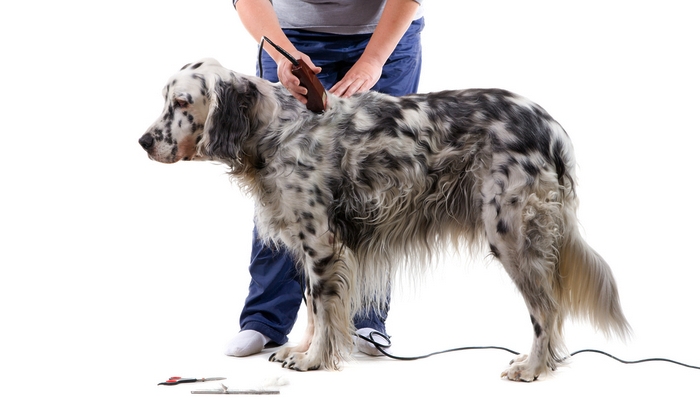Dog grooming can be a very daunting task. It's intimidating to many dog owners, but if you learn how to groom a dog properly you could save yourself hundreds of dollars each year. It's not as difficult as you think, and the price of the right at-home grooming supplies will be much lower than the price of professional dog grooming costs.
Depending on the breed of dog you have, his size and his coat type, you may have a grooming intensive pet. While there are grooming tasks that won't need to be performed on every dog, like haircuts and cleaning tear stains, there are a number of tasks that ALL dogs require. These grooming tasks include:
- bathing
- brushing
- nail trimming
- ear cleaning
- teeth cleaning
This guide is just meant to be a general overview of the many grooming tasks that a pet parent will need to perform (or hire someone to perform). I've made detailed video guides on each specific task. If you know everything you need to know about brushing your dog, you can skip that one and focus on learning about the tasks you're less confident about.
Remember, if you are very nervous you need to work with a professional in the beginning. Your dog will pick up on your nervous energy, and it will make it much more difficult to learn how to groom a dog if you and your pet are both anxious and stressed.
How To Groom A Dog at Home by Yourself
Grooming your dog's coat and skin
When discussing how to groom a dog, this is one area that most pet owners feel pretty comfortable with. First, you'll need to be sure that you have the right brush for your dog's coat type. For more information on which brush may be right for your Fido, check out our guide to dog brushes.
Ideally, you should brush your dog every day. Not only will this reduce the amount of shed hair found around your home, it will also help to stimulate the production of healthy oils and the brushing action helps to spread the oils over the entire coat. This aids in overall coat health, as well as providing a shiny appearance and soft feel.
FULL WRITTEN GUIDE ON BRUSHING: How To Stop Dogs From Shedding
Brushing your dog before giving him a bath is important. Even for short haired dogs, you need to make sure you brush any mats or tangles out of his coat before washing. If you don't, your fingers could get caught in one of these tangles while scrubbing your pooch. It will pull his fur and cause him a lot of pain.
Before bathing your dog you'll need to consider where this grooming task is going to take place. If you have multiple pups and bathe them frequently, you may want to invest in a dog grooming tub. If you live in a warm climate, you can bathe Fido outside. It might be easier (and cheaper) to use your own bathtub, though.
Once you've set a location, you'll need to stock up on supplies. One common misconception among dog parents is that all pet shampoos are created equal. Sadly, this is VERY untrue.
Remember that all of the dog grooming supplies that you buy need to be MADE FOR DOGS. Products for humans are NOT SAFE to use with pets.
First of all, every dog can benefit from the use of canine conditioner. It helps to keep their skin and coat soft, shiny and well moisturized. Secondly, when purchasing shampoo and conditioner you need to look for quality products that are made with safe, natural ingredients.
Artificial ingredients and colors along with chemical cleaners can be very harmful to dogs. They will dry out your dog's skin, essentially doing the exact opposite of what they are supposed to do. While they may clean your dog's skin and coat, they will do more damage than good in the long run.
FULL WRITTEN GUIDE ON DOG BATHING: How To Bathe A Dog
The final step in grooming a dog's skin and coat is to give him a haircut. Of course, this isn't a necessary step in learning how to groom a dog. Not all breeds require hair cuts, and some require more extensive cuts than others.
This is a topic that really requires an answer specific to each dog. Some dogs, including dogs with double coats, should never be shaved. Others may be shaved or clipped. You should speak with a professional groomer about your dog's specific needs before investing in any products to trim his coat.
While you may be able to get away with shaving your dog's coat, it's likely that he will also need the hair on his face trimmed. This is a delicate task that needs to be done with extreme caution. While you're clipping their facial hair, you'll also have to pay attention to tear stains.
You can learn more about cleaning dog tear stains in this quick video guide.
Working with a professional for the first few trims will give you the ability to see how to groom a dog with clippers and scissors, so you'll be more confident when striking out on your own.
FULL WRITTEN GUIDE ON USING CLIPPERS: How To Use Dog Clippers
Smaller dog grooming tasks
Most pet owners are pretty comfortable bathing and brushing their pet. When it comes to some of the smaller grooming tasks, some people think they can get away without keeping up with them. This is absolutely untrue.
You need to be sure to keep up with your dog's nails, teeth, ear and paw care. While some dogs will need more frequent grooming than others, all dogs need their nails trimmed and their teeth and ears cleaned.
When cleaning your dog's ears, you need to find a safe and effective cleaner. You can find wipes that are very convenient or use a dog ear cleaning solution on cotton balls.
FULL WRITTEN GUIDE FOR EAR CLEANING: How To Clean A Dog's Ears
Canine dental care is one of the most commonly forgot tasks when learning how to groom a dog. According to the American Veterinary Dental College, periodontal disease is the most commonly occurring clinical condition seen in adult dogs and cats. The only way to prevent this condition is by brushing your dog's teeth regularly.
There are water additives that can help stop plaque from building on your pet's teeth. There are also many dental chews that claim to be just as good as brushing. They are not, and don't buy into those claims. The only thing that will keep plaque and tartar from becoming an issue for your pet is regular brushing.
I know it may seem intimidating at first, but most dogs will eventually warm up to the idea of having their teeth cared for. Be sure to purchase a toothbrush and toothpaste that are specifically made for dogs.
FULL WRITTEN GUIDE FOR TEETH BRUSHING: How To Brush A Dog's Teeth
Now, the final small task that you'll need to tackle when learning how to groom a dog. It is the grooming task that most dog owners dread – nail trimming. While your'e trimming his nails, you'll also want to trim the hair between the pads of your pup's feet.
It's important to keep the hair of the paws trimmed. If it gets too long, this hair can become easily matted and cause your dog a lot of pain.
You have a few different options when it comes to nail trimming. Scissor style clippers are the most common, followed by guillotine style clippers. Both of these cut the tip of the nail off. You could also use a rotary tool that will slowly file down the tip of the nail.
While rotary tools may make you feel more comfortable, they are not nearly as quick and they also make a loud noise. Most dogs are already uncomfortable while having their nails clipped, so adding the noise of a small motor may escalate the dog's anxiety.
FULL WRITTEN GUIDE FOR NAIL CLIPPING: How To Cut Dog's Nails
Your dog may have other additional grooming needs, but these are the basics that you'll start with when learning how to groom a dog. Underlying health conditions such as skin conditions or allergies may change how you groom your pet.
As I mentioned, it's best to have a conversation with a professional groomer, or at the very least your veterinarian, before grooming a dog for the first time. Grooming is a great preventative measure to keep your pet healthy, but when done wrong can also cause serious injuries (to you and your pooch).
READ NEXT: Dog Grooming Supplies 101 – The Ultimate Buyers’ Guide













